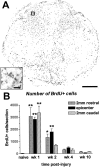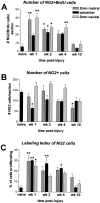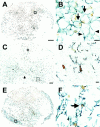Proliferation of NG2-positive cells and altered oligodendrocyte numbers in the contused rat spinal cord
- PMID: 11331369
- PMCID: PMC6762495
- DOI: 10.1523/JNEUROSCI.21-10-03392.2001
Proliferation of NG2-positive cells and altered oligodendrocyte numbers in the contused rat spinal cord
Abstract
Given the numerous reparative roles glia may play after spinal cord injury (SCI), glial proliferation and cell number were examined in a model of traumatic SCI. Emphasis was placed on analysis of oligodendrocytes and NG2-positive (NG2+) cells, an endogenous cell population that may be involved in oligodendrocyte replacement. Overall, proliferation (assessed by bromodeoxyuridine incorporation) was markedly elevated during the first 2 weeks after injury and declined thereafter; a large portion of these dividing cells likely consisted of microglia-macrophages. Although the total number of NG2+ cells in the epicenter was reduced by half, we noted protracted proliferation in surviving NG2+ cells, with values sevenfold greater than in uninjured controls. Elevated proliferation of NG2+ cells persisted throughout the first 4 weeks after injury. However, the absolute number of NG2+ cells was not increased over controls, suggesting that the daughter cells either did not survive or they differentiated into other cell types. As expected, oligodendrocyte numbers were drastically altered after SCI. By 7 d after injury, the number of oligodendrocytes at the impact site was reduced by 93%. Despite ongoing tissue loss, the number of oligodendrocytes in spared tissue rose threefold at 14 d after injury. Although the function of NG2+ cells within the spinal cord is not completely understood, several studies suggest that they may differentiate into oligodendrocytes. Thus, proliferating NG2+ cells may contribute to the increased oligodendrocyte number observed at 2 weeks after injury. Future studies are required, however, to definitively determine the role NG2+ cells play in oligodendrocyte genesis, remyelination, and other post-injury events.
Figures





Similar articles
-
Mixed primary culture and clonal analysis provide evidence that NG2 proteoglycan-expressing cells after spinal cord injury are glial progenitors.Dev Neurobiol. 2007 Jun;67(7):860-74. doi: 10.1002/dneu.20369. Dev Neurobiol. 2007. PMID: 17506499
-
NG2 is a major chondroitin sulfate proteoglycan produced after spinal cord injury and is expressed by macrophages and oligodendrocyte progenitors.J Neurosci. 2002 Apr 1;22(7):2792-803. doi: 10.1523/JNEUROSCI.22-07-02792.2002. J Neurosci. 2002. PMID: 11923444 Free PMC article.
-
Increase of NG2-positive cells associated with radial glia following traumatic spinal cord injury in adult rats.J Neurocytol. 2005 Dec;34(6):459-69. doi: 10.1007/s11068-006-8998-4. Epub 2006 Aug 10. J Neurocytol. 2005. PMID: 16902766
-
Identity, distribution, and development of polydendrocytes: NG2-expressing glial cells.J Neurocytol. 2002 Jul-Aug;31(6-7):437-55. doi: 10.1023/a:1025783412651. J Neurocytol. 2002. PMID: 14501215 Review.
-
The reactions and role of NG2 glia in spinal cord injury.Brain Res. 2016 May 1;1638(Pt B):199-208. doi: 10.1016/j.brainres.2015.07.026. Epub 2015 Jul 29. Brain Res. 2016. PMID: 26232070 Free PMC article. Review.
Cited by
-
Intertwining extracellular nucleotides and their receptors with Ca2+ in determining adult neural stem cell survival, proliferation and final fate.Philos Trans R Soc Lond B Biol Sci. 2016 Aug 5;371(1700):20150433. doi: 10.1098/rstb.2015.0433. Philos Trans R Soc Lond B Biol Sci. 2016. PMID: 27377726 Free PMC article. Review.
-
CNTF promotes the survival and differentiation of adult spinal cord-derived oligodendrocyte precursor cells in vitro but fails to promote remyelination in vivo.Exp Neurol. 2007 Mar;204(1):485-9. doi: 10.1016/j.expneurol.2006.12.013. Epub 2006 Dec 20. Exp Neurol. 2007. PMID: 17274982 Free PMC article.
-
Localization of Nogo-A and Nogo-66 receptor proteins at sites of axon-myelin and synaptic contact.J Neurosci. 2002 Jul 1;22(13):5505-15. doi: 10.1523/JNEUROSCI.22-13-05505.2002. J Neurosci. 2002. PMID: 12097502 Free PMC article.
-
Aberrant growth and differentiation of oligodendrocyte progenitors in neurofibromatosis type 1 mutants.J Neurosci. 2003 Aug 6;23(18):7207-17. doi: 10.1523/JNEUROSCI.23-18-07207.2003. J Neurosci. 2003. PMID: 12904481 Free PMC article.
-
Permissive Schwann cell graft/spinal cord interfaces for axon regeneration.Cell Transplant. 2015;24(1):115-31. doi: 10.3727/096368913X674657. Epub 2013 Oct 22. Cell Transplant. 2015. PMID: 24152553 Free PMC article.
References
-
- Adrian EK., Jr Cell division in injured spinal cord. Am J Anat. 1968;123:501–520. - PubMed
-
- Adrian EK, Jr, Walker BE. Incorporation of thymidine-H3 by cells in normal and injured mouse spinal cord. J Neuropathol Exp Neurol. 1962;21:597–609. - PubMed
-
- Adrian EK, Jr, Williams MG, George FC. Fine structure of reactive cells in injured nervous tissue labeled with 3H-thymidine injected before injury. J Comp Neurol. 1978;180:815–839. - PubMed
-
- Amat JA, Farooq M, Ishiguro H, Norton WT. Cells of the oligodendrocyte lineage proliferate following cortical stab wounds: an in vitro analysis. Glia. 1998;22:64–71. - PubMed
-
- Balentine JD. Pathology of experimental spinal cord trauma. II. Ultrastructure of axons and myelin. Lab Invest. 1978;39:254–266. - PubMed
Publication types
MeSH terms
Substances
Grants and funding
LinkOut - more resources
Full Text Sources
Other Literature Sources
Medical
Research Materials
